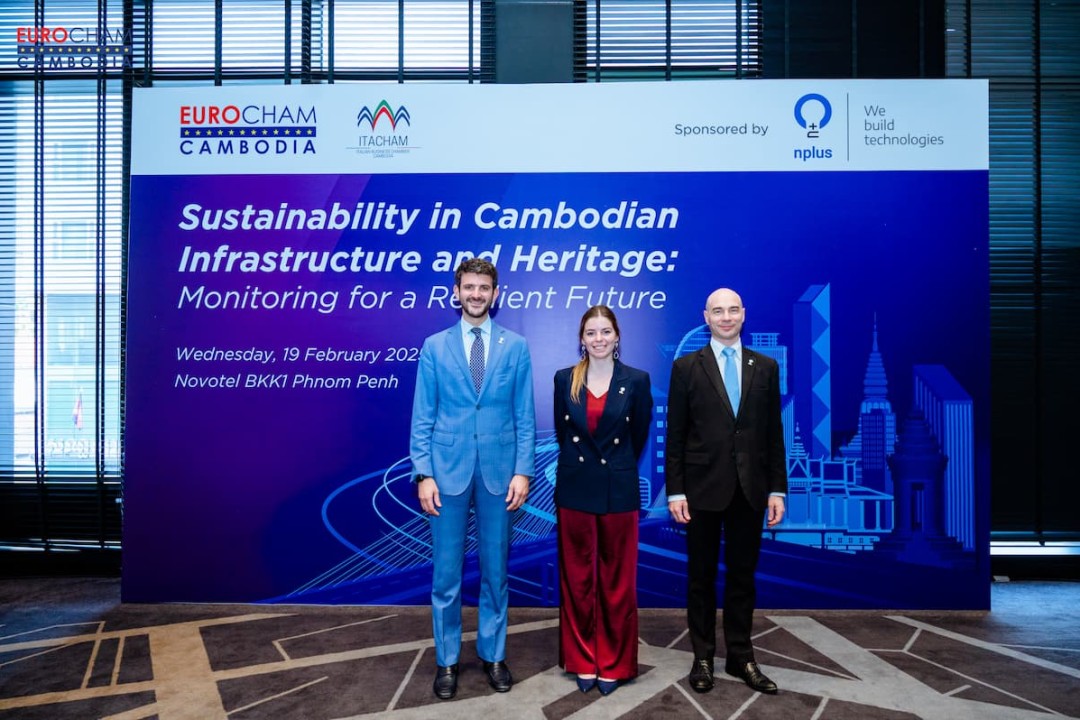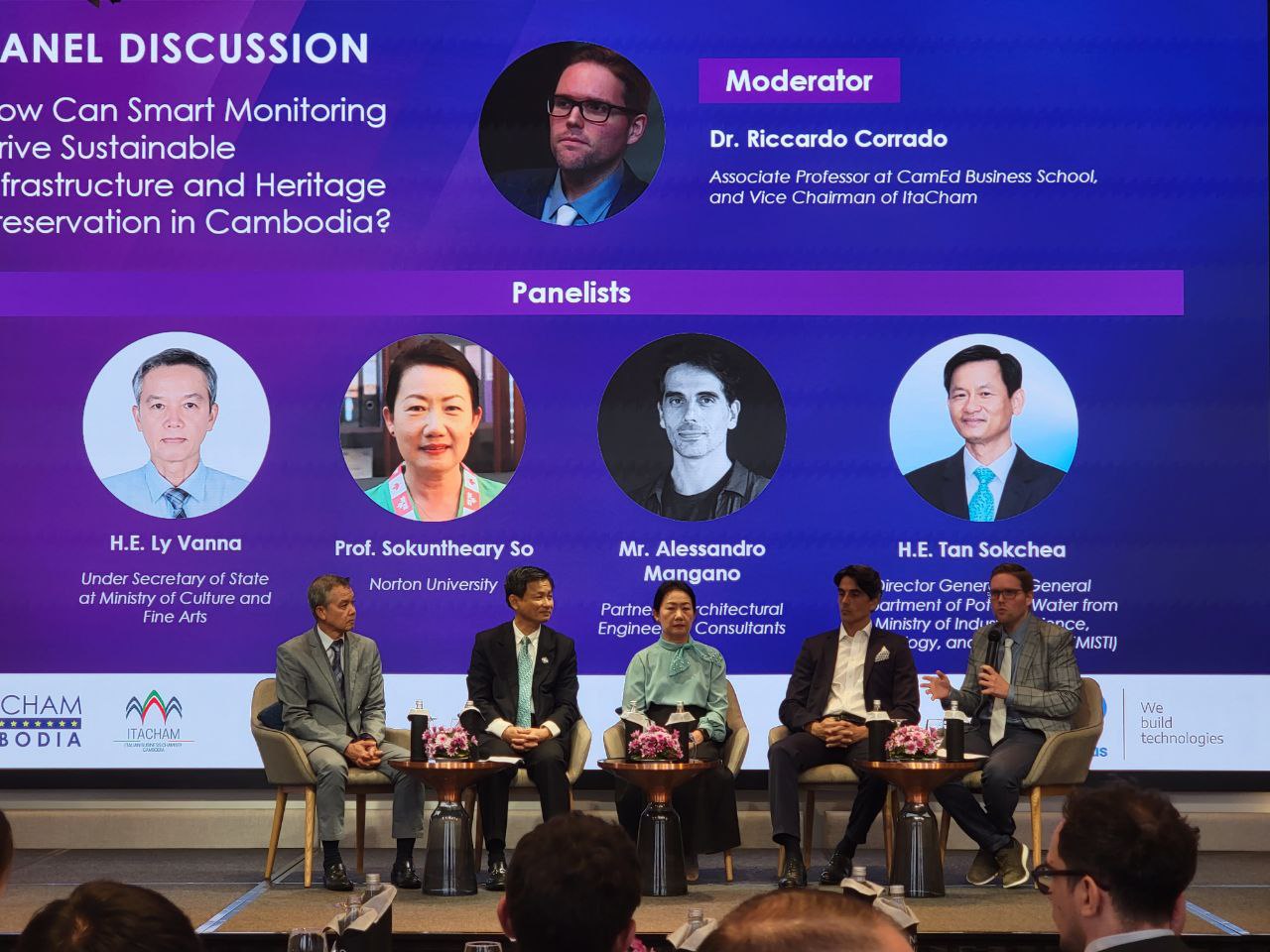How Can Cambodia Benefit From Infrastructure Health Monitoring Systems?

The Cambodian government has prioritised infrastructure development to become a regional logistics hub. The Kingdom is also home to many global heritage sites; to ensure the long-term viability of these projects, comprehensive Structural Health Monitoring (SHM) systems are essential.
A discussion on how infrastructures can be monitored and how Cambodia can benefit from this advanced technology was held during the joint EuroCham Cambodia and the Italian Business Chambers in Cambodia (ItaCham) seminar titled "Sustainability in Cambodian Infrastructure & Heritage: Monitoring for a Resilient Future" on February 19, 2025.
The event was organised in partnership with Nplus, a global leader in infrastructure monitoring and a member of the Giordano Riello International (GRIG) group, which shared how its expertise can benefit Cambodian universities, institutions, and companies in Cambodia.
The event opened with remarks from Martin Brisson, Executive Director of the European Chamber of Commerce. He underscored the necessity of embracing cutting-edge technologies to support Cambodia’s sustainable development.
He shared, “Cambodia faces climate-related challenges such as flooding and extreme weather, which put stress on both new and ageing infrastructure. Without effective monitoring, deterioration can go unnoticed until it is too late, leading to higher maintenance costs and potential safety risks.”
He added that modern infrastructure demands smart monitoring, as well as Cambodia’s vast and ageing cultural heritage. Historical sites, from ancient temples to centuries-old buildings, are difficult to monitor comprehensively. “Without the right tools, protecting these sites becomes a race against time.”
_20250220_152224.jpg)
Structural Health Monitoring (SHM)
According to Science Direct, SHM is used for continuous or periodic monitoring of structures like buildings, bridges, and dams to assess their integrity and detect damage.
The event’s keynote address was presented by Dr. Francesca Brighenti, International Sales Director of Nplus who is a SHM Specialist and has a PhD from the University of Trento. She shared her extensive international expertise, showcasing successful SHM case studies and underlining Nplus’ global leadership in the field.
_20250220_152142.jpg)
Dr. Brighenti’s address detailed how SHM technologies enable:
- Optimised infrastructure maintenance, preventing structural deterioration.
- Cost reduction through predictive, data-driven maintenance strategies.
- Enhanced safety for bridges, viaducts, and critical infrastructure.
She discussed Italy's experiences with bridge and viaduct fragility. Some of these incidents led to casualties and impacts on citizens and economic activities. In Italy, the case of the Morandi Bridge collapse in 2018 raised awareness about infrastructure maintenance and management, leading to significant SHM regulations and guidelines.
How Can SHM Technologies Benefit Cambodia?
Dr. Brighenti added that structural monitoring can be used to preserve Cambodia’s historical and architectural heritage, where SHM can mitigate risks and ensure long-term conservation, as demonstrated by Nplus’ case study on the structural monitoring of Milan Cathedral (Duomo di Milano).
Mr. Giordano Riello, President of Nplus, stressed that monitoring not only helps maintain these sites in good conditions but also showcases the significance of the historical pride associated with them.
The event was followed up by a panel discussion moderated by Prof. Riccardo Corrado, Associate Professor at CamEd Business School and Vice-President of ItaCham which focused on technology, infrastructure, and heritage preservation.

The panel included H.E. Ly Vanna, Undersecretary of the State Ministry of Culture and Fine Arts, H.E. Tan Sokchea, Director General of the General Department of Portable Water at MISTI, Professor Sokuntheary So of Norton University (an architect who worked on Sambo Prei Kuk conservation project) and Alessandro Mangano (partner at Architectural Engineering Consultants)
- H.E. Ly Vanna - stressed the importance of monitoring technologies in preserving crucial historical sites while respecting Cambodia’s cultural heritage.
- H.E. Tan Sokchea - emphasised the role of monitoring technologies in ensuring water infrastructure safety and efficiency.
- Prof. Sokuntheary So - shared her expertise on architectural heritage preservation.
- Mr. Alessandro Mangano - detailed his experience in SHM for the Colosseum in Rome, recognising the value of the Nplus Milan Cathedral case study and highlighting the importance of applying SHM to modern buildings, where design flaws and structural defects may arise.
Cambodian 2025 Sector News
- Key Takeaways - Cambodia Real Estate Highlights Knight Frank H2 2024 Report.
- DIGITECH-25: ‘Unlocking the Power of Data’ For Cambodian Provincial Enterprises.
- The First Cambodia EdTech Summit Opens To Promote New Pathways For The Future Of Cambodia’s Digital Education